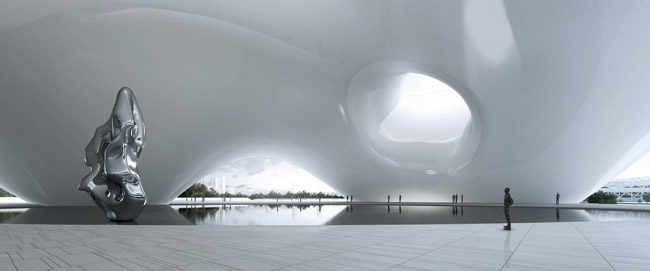According to multiple sources, Jean Nouvel has been selected to design a mega-sized new building for the National Art Museum of China (NAMOC) in Beijing. If reports are true, the Pritzker Prize–winning French architect has beat out Frank Gehry and Zaha Hadid to snag the highly coveted commission. One well-placed source (who, like others, asked not to be identified because he was not authorized to speak on the record) says all three architects were informed of the decision on July 18.
The source added that an official announcement will not come until November, after the national government goes through its once-in-a-decade change in leadership. NAMOC and Gehry’s office declined to comment, while a spokesperson for Nouvel did not respond to several requests for comment. At 1.3 million square feet, the new structure will be mammoth. It is the most prominent of a trio of buildings (the others are a museum devoted to arts and crafts and a sinology museum) being planned for a site next to the Herzog & de Meuron–designed National Stadium, known as the Bird’s Nest. Part of a broader effort to draw more people to visit the area, post-Olympics, it is also probably the most symbolically important cultural building on the boards in China. “We were told to make a building so iconic that one day people will say that the Bird’s Nest is next to it,” said one early contender.
Nouvel’s likely selection ends a process that, when it began in earnest in 2010, sent more than 150 architects from around the world scrambling to partner with Chinese artists, one of NAMOC’s original recommendations. Twenty offices were then invited to submit designs, among them OMA, UNStudio, and the Chinese architects Yung Ho Chang, Zhu Pei, and Ma Yansong of MAD. From these, five finalists, including Herzog & de Meuron (who withdrew from consideration) and Moshe Safdie, were asked to make revisions. “It was intense,” says Safdie.
A recent sneak peek of the three final-cut entries by Nouvel, Gehry, and Hadid shows that all are similarly massed. [Nouvel's office did not respond to requests for images of the firm's design, but click the rendering above to view the other finalists.] With its “scrolling” forms, Hadid’s glass- and glass-fiber-clad proposal looks not so much like some sleek spacecraft as the slow-moving mothership that might have launched it. “There were a lot of constraints and a lot to pack in, so you wound up with volumetrically very similar proposals,” says Cristiano Ceccato, Hadid’s associate in charge of the project. (Ceccato would neither confirm nor deny the results of the competition.) Meanwhile, topped by warped volumes, Gehry’s otherwise boxy scheme features facades of scooped and scalloped metal behind “translucent stone” made of glass. By most accounts, the contest came down to a head-to-head between Gehry and Nouvel, the latter presumably winning with a somewhat softer-edged proposal offering a pastiche of envelope treatments: steel cut in decorative patterns, stenciled glass recalling Chinese ink brushstrokes, and a splash of parametricism, all explained via references to ancient Chinese poetry and philosophy.
The NAMOC commission is part of China’s ambitious plans to develop its cultural infrastructure and “soft power.” The museum’s current Sino-Soviet-style building, which is not far from the Forbidden City and will remain an art museum, was one of the “10 Great Buildings” constructed under Mao Zedong in 1959. NAMOC is best known for its exhibitions of 20th-century and contemporary Chinese art. The proposed new edifice, meanwhile, offers a fresh reminder of how soft power nowadays works both ways. Rumors of political machinations at the highest levels surrounded the competition, with various nations supposedly jockeying to influence the selection process in favor of their own architects. Such speculations may have been unfounded, but they were not dampened when Gehry very visibly gave Xi Jinping, China’s presumptive next president, a tour of his Walt Disney Concert Hall during Xi’s high-profile visit to Los Angeles earlier this year.
The new NAMOC is thought to be scheduled for completion in 2015. How the museum will manage to fill its square footage remains unclear. Adding further uncertainty is the widespread belief that NAMOC director Fan Dian, who enjoys a reputation as a progressive administrator, will soon be promoted to another job. What’s for sure is that the process of choosing the building’s design was both political and opaque. But there were positive aspects to the process, too. “Unlike other competitions, there was a lot of contact,” says Safdie, recalling his numerous travels and visits with museum officials. (Nevertheless, he says he does not know who was on the jury that selected the final three in April.) “There was a lot of consultation and dialogue with the client,” Ceccato concurs.





















Post a comment to this article
Report Abusive Comment